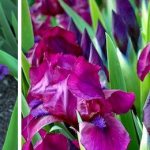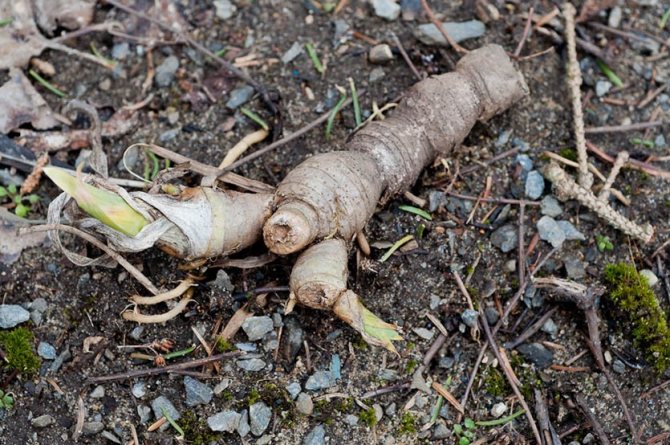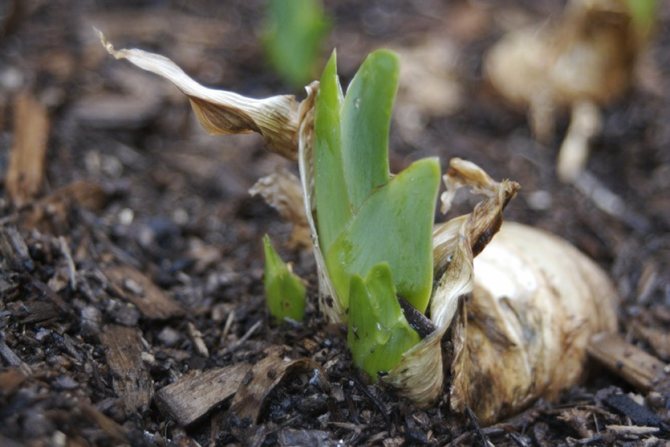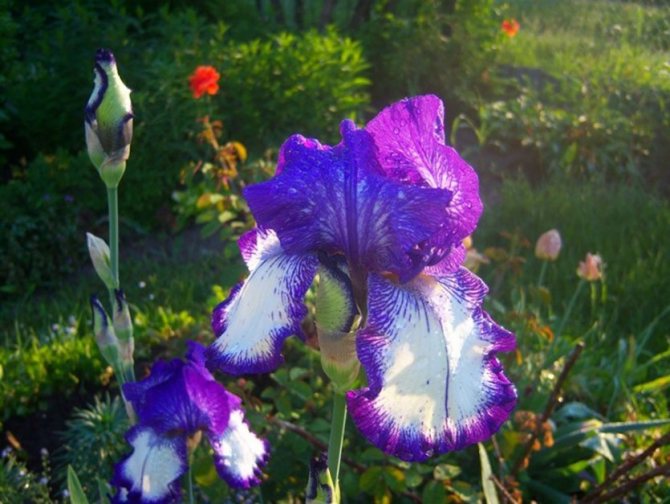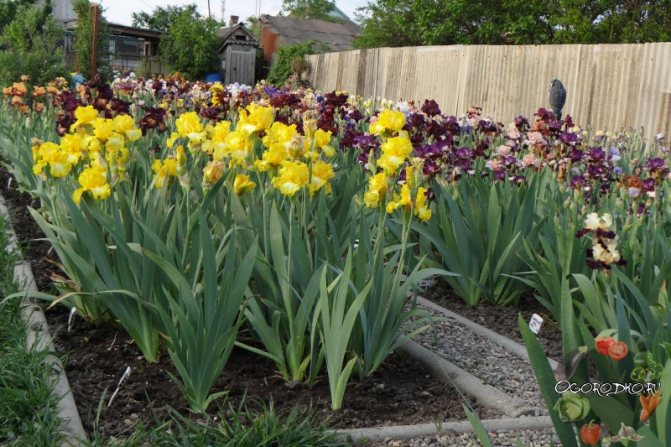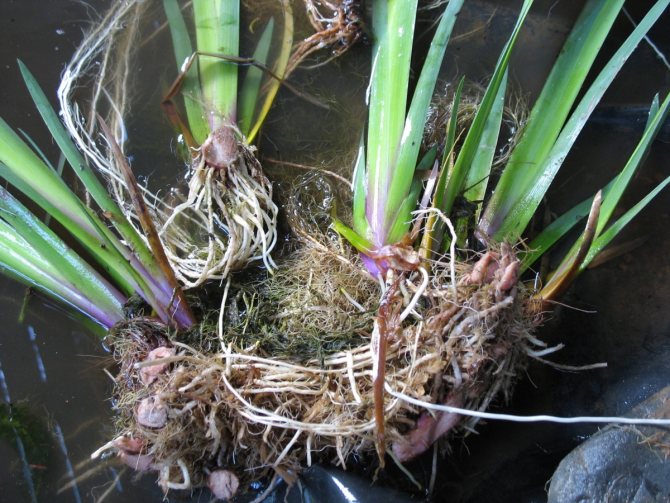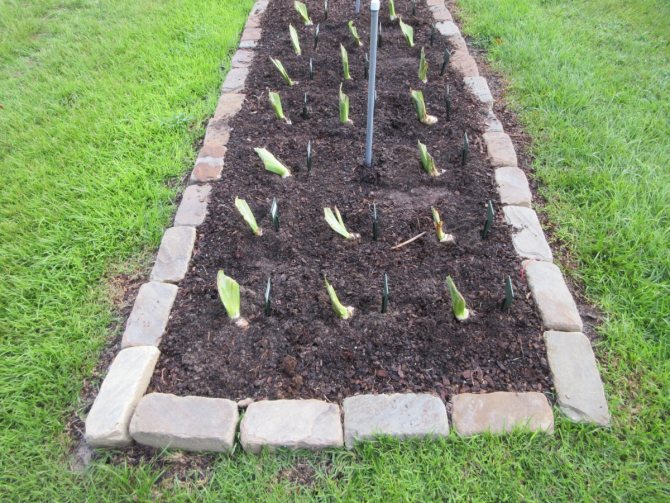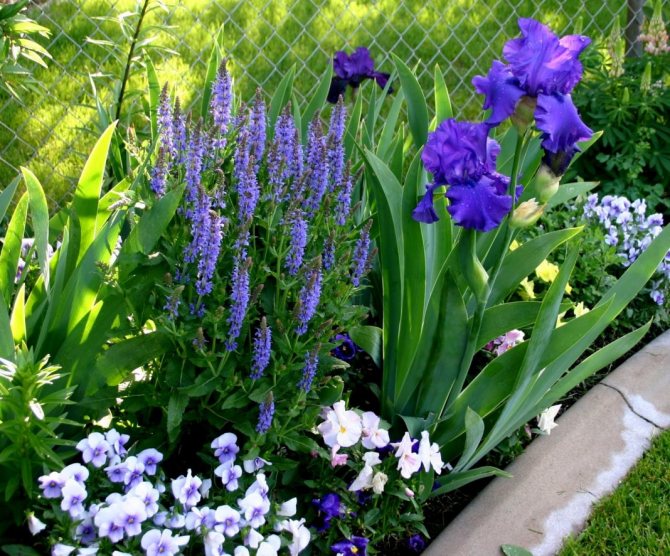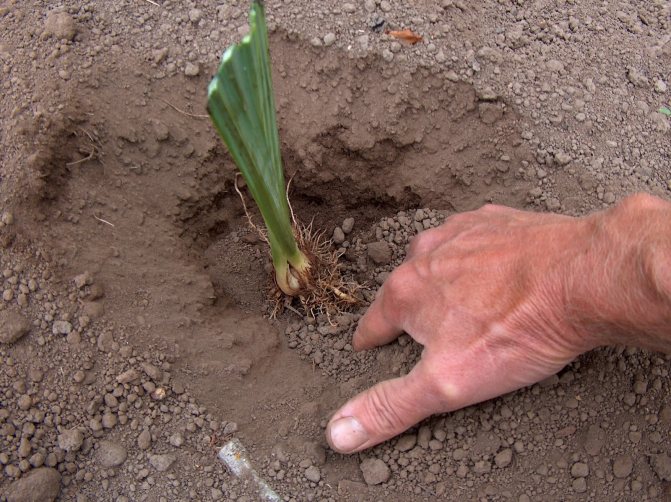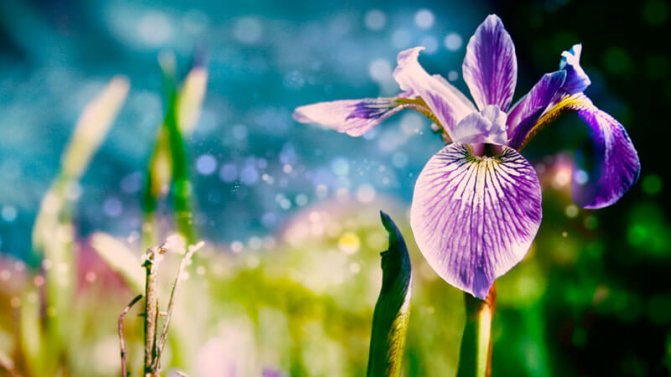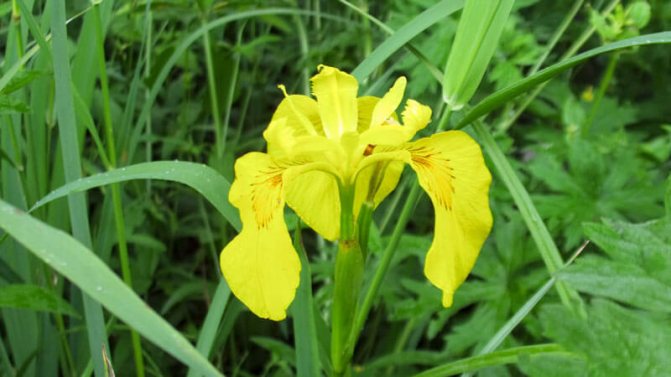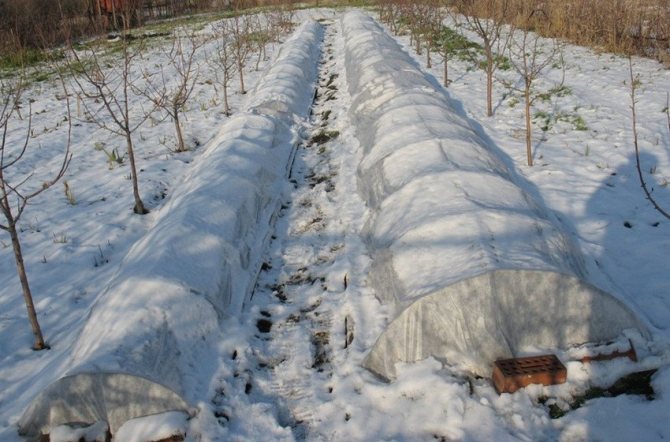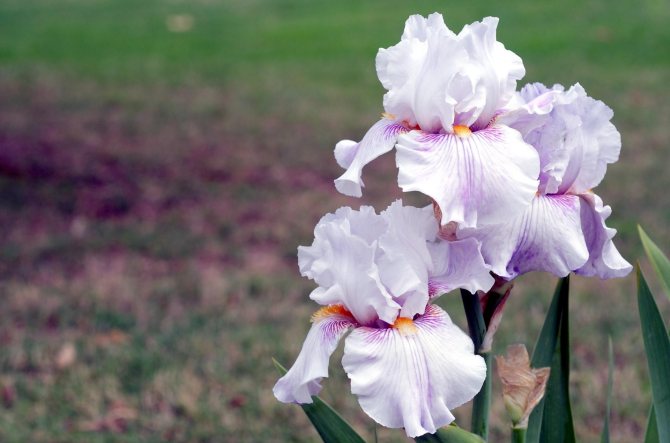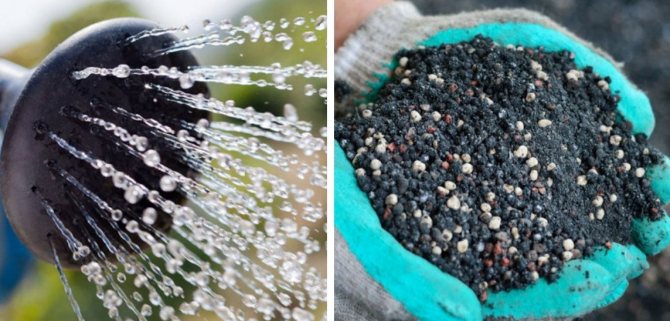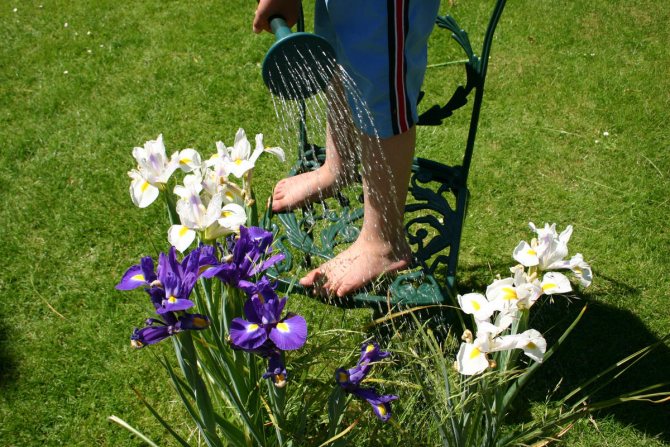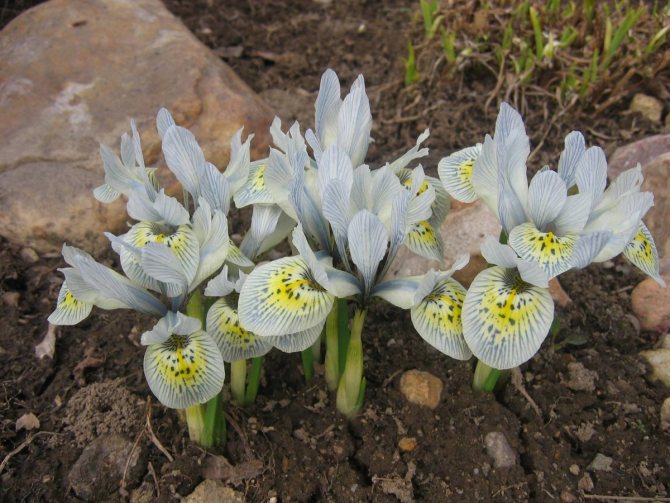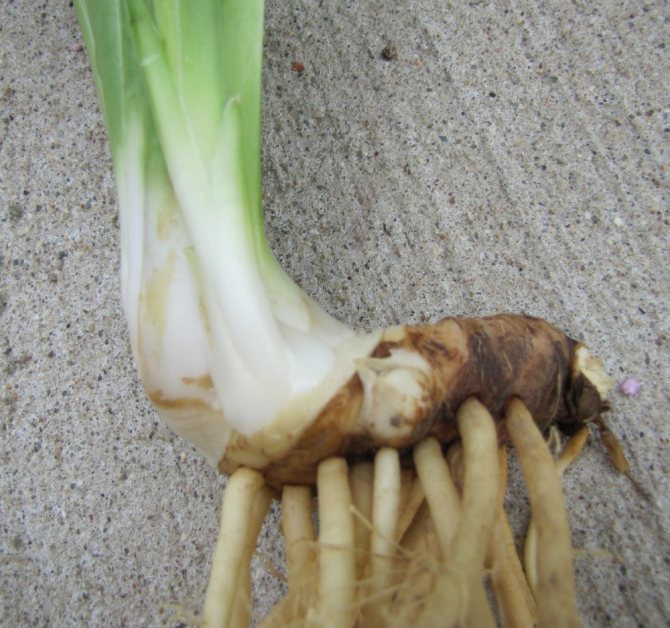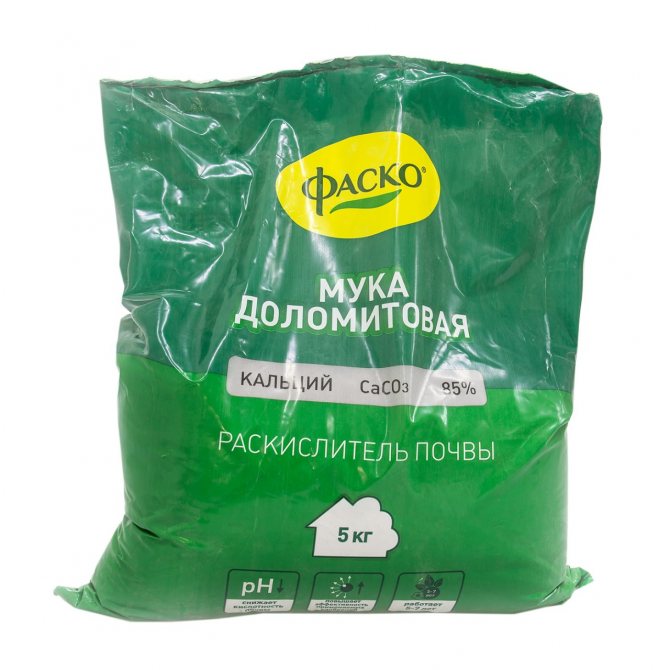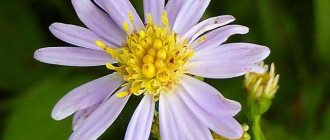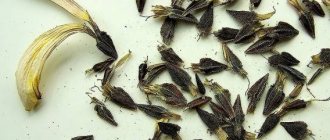Irises are amazingly beautiful perennial bulbous flowers that amaze the imagination with a variety of shapes, colors and shades. This is probably why they got their name (from the Greek "iris") after the Greek goddess of the rainbow Iris.
The first mentions of iris in the annals of Ancient Egypt date back to the 15th century BC. It tells about iris in the legends of Southeast Asia, Ancient Rome, Scandinavian countries and even Ancient Russia.
We have heard that it was the favorite flower of the Slavic god Perun, who called it "a symbol of spiritual purity, immense courage and desperate bravery." And then the iris was called in Russia "kasatik".
The people said that glades with flowering iris appear where Perun sent fire lightning. These places were considered reserved, curing any disease and fulfilling the most cherished desire.
But only a person with a bright and pure soul, who was also lovingly called Kasatik, could find the way there.
Iris flower meadows can be found in the central and southern regions of Russia, as well as in Siberia in the South Urals and the Far East.
The name of the flower in Russia remained until the beginning of the 20th century, and then another (scientific) one appeared - iris, when serious breeding work began all over the world to create new varieties and hybrids of this lovely flower that could decorate any flower bed.
In the 20s of the last century, iris breeding was actively pursued in many European countries, as well as in the USA and Canada, Japan and Australia. These works were carried out in our country as well.
Since then, more than 40 thousand of the most diverse and spectacular varieties have been bred. If you choose them correctly, then the irises will bloom in your flower bed from late April to mid-August.
This flower is quite unpretentious and tolerates weather anomalies well. In addition, modern irises practically do not get sick. And planting in open ground and caring for them is not difficult.
Iris flowers are actively used in cooking. They make jam from them, make rich starchy flour for cakes, use them as capers in a marinade, add to soups and meat dishes as a seasoning.
Irises give off a wondrous, delicate aroma that fills the garden with an amazing magical scent. Therefore, plants are widely used in the perfumery industry for the manufacture of perfumes, creams, deodorants and very expensive powders.
In this article, we will tell you how to plant iris correctly, how to care for it and help you choose the best species and varieties for your site.
Transplanting irises in the fall to another place
Irises can be planted both in spring and autumn. However, if you want bulbous irises to surely delight you with flowering next season, then give preference to an autumn planting.
Autumn planting and transplanting of irises is performed immediately after the leaves of the plant have dried. The bulbs are cleaned from the soil, the baby is separated, then the planting material is dried and planted in a new place in late September or early October. Plants use the warm season to take root, but they will not have time to grow.
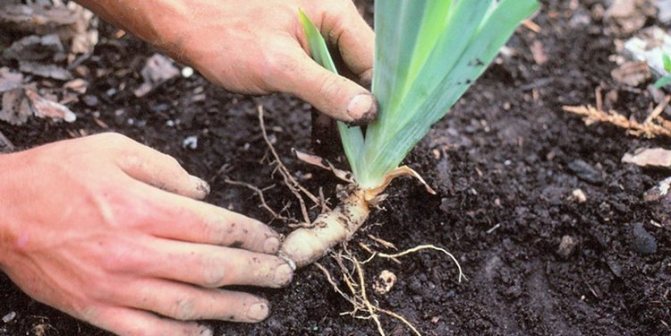
Rhizome irises after division are planted in the same way.Moreover, both those and other freshly transplanted flowers must be covered for the winter, regardless of their variety, because they are still too weak for independent wintering. What flowers can still be planted in autumn, read here.
IRISES: LANDING IN OPEN GROUND
Planting iris bulbs in open ground is carried out either at the end of April, as soon as the ground thaws, or at the end of September. In this case, the soil temperature should be at least 12 degrees.
The bulbs are planted in an area well-lit by the sun. Iris need soils neutral or, in extreme cases, slightly acidic (pH 6.5 - 7.0). The depth of the well depends on the size of the bulb. Taking into account the drainage from the sand, which is laid out on the bottom with a layer of 5 cm, it should be no more than 12 cm.
The distance between the plants is 15 cm. The planting soil is prepared from the top fertile layer, compost and sand in equal proportions. Phosphorus-potassium fertilizers (superphosphate and potassium sulfate) and ash are added to each well.
When planting the bulbs, the sprout must point upwards. The wells are covered with planting mixture and tamped well so that the bulb is completely covered with earth.
The plantings are immediately well watered with warm water and, if any bulb is bare, they cover it with earth from above.


Pruning irises for the winter
Pruning is carried out after flowering in the fall. In summer, bettas cannot be cut off, since the leaves contain a supply of nutrients that the flowers need for wintering. Some species bloom twice, so only those peduncles that have already begun to dry out are cut off. Blooming once are cut off only at the peduncle. It is removed completely. Yellowed leaves are also cut off. Greens don't touch it yet.
The greens are cut at a level of 10 cm from the ground. A triangular cone-shaped cut is made with the apex in the center of the fan. This event is left for the fall - mid or late October. Autumn pruning of irises is necessary for the prevention of diseases or the spread of pests. The cut greens are burned.
If you do not cut the flower stalks, seeds are formed in them. This can lead to uncontrolled reproduction of the species on the site. Seed material from varietal species is unsuitable for reproduction. Most often, the offspring lose the characteristic features inherent in the mother plant, and they will begin to bloom only after 2 - 3 years.


FEATURES OF VARIOUS IRIS TYPES
There are many types of irises, most of which are very thermophilic and do not grow in our climate.
For domestic gardeners, only 4 types of irises may be of interest: bearded (the largest group), siberian, Louisiana and Japanese.
Bearded irises. Basically, they grow in flower beds of domestic amateur gardeners and are subdivided into: miniature (up to 45 cm); medium-sized (up to 65 cm); high (above 70 cm).
Bearded irises are amazingly beautiful and come in a wide variety of shapes and colors. These are very bright, luxurious flowers that adorn the garden from May to August. They are not afraid of winter frosts and have increased resistance to fungal diseases.
They love the sun, but they will grow well in partial shade. Look great in any flower beds and in the middle tier of alpine hills.
Siberian irises... These are very graceful plants with numerous medium-sized delicate flowers (up to 50 peduncles per plant) and narrow thin leaves. The color palette of flowers is no less varied, but the tones are not so defiantly bright, but more delicate and charming.
And the aroma of flowers is more delicate and surprisingly pleasant, which gives additional attractiveness to this species. Siberian irises bloom the longest - until the end of August.
They are very unpretentious and frost-resistant, withstanding winter frosts down to -42 degrees. Diseases are practically not affected at all. They can do without watering for a long time.
They tolerate partial shade and even shady areas very well, which greatly expands the possibilities of their use in flower arrangements.
Louisiana irises... This species was found in the wild in southern Louisiana in the United States. On its basis, many varieties have been created, among which there are quite frost-resistant ones. Record holder for growing in cold climates - variety Rhett.
The flowers of Louisiana irises are large and bright. They will grow and bloom well only in a fully illuminated, sunny place. This type is interesting in that it can be used to decorate reservoirs.
These irises can be planted not only in a flower garden, but also on the bottom of small artificial ponds to a depth of no more than 25 cm.
Japanese iris... A very large flower (up to 30 cm in diameter) with long (up to 65 cm) graceful leaves. Used by designers as an accent plant in any flower garden.
Japanese iris is stunningly beautiful, but, alas, its frost resistance is quite low (below -20 degrees). However, there is one variety that can be grown in the colder climates of most parts of Russia. It - Smile.
This variety tolerates severe frosts well, but requires winter shelter with a double layer of spruce branches, covered on top with a dense non-woven material.


Autumn feeding of irises
after pruning Usually, after the end of flowering, such plants should not be watered often, a couple of waterings during the fall season are enough. And if the autumn is rainy, then these perennials should not be additionally watered. Important! These plants do not tolerate organic fertilizers well, so they should not be fertilized with manure or chicken droppings.
The best fertilizers for irises are mineral fertilizers. However, it should be remembered that nitrogen is applied under these flowers only before flowering begins. But in the fall, two weeks before pruning or two weeks after it, these flowering perennials are fertilized with a complex mineral fertilizer, which includes any potassium salts and superphosphate. However, it should be remembered that if fertilizing is applied after pruning, then at least 14 days must remain before the onset of frost.
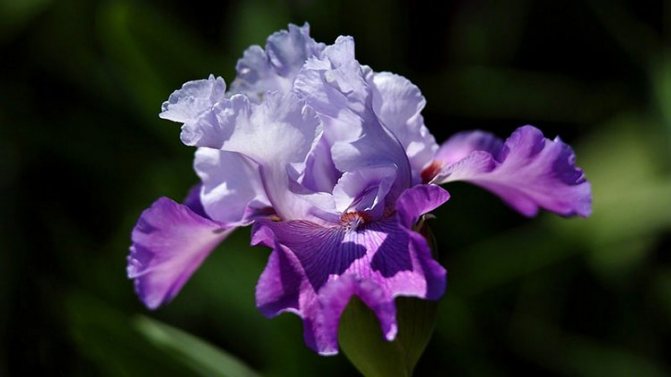

Varietal variety
Delicate wild-growing irises grow on rocks, in the steppes. For cultivation in greenhouses and cultivation in summer cottages, more than 500 varieties have been bred, which are conventionally divided into categories.
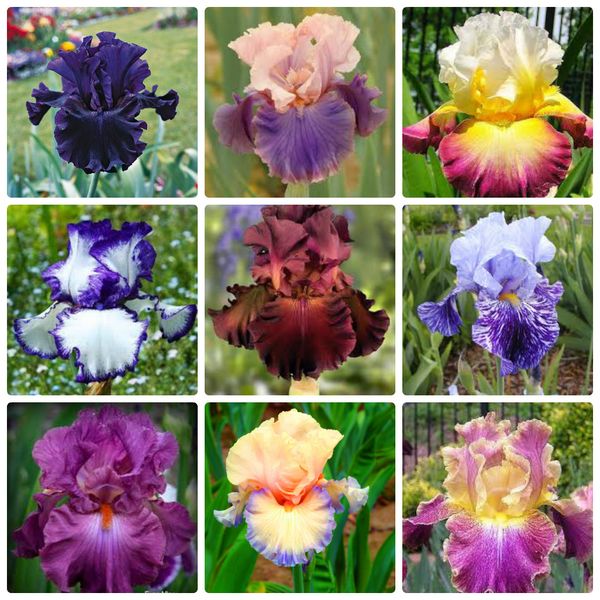

The most popular are:
- bearded irises, which are distinguished by the lower petals, which have small fine hairs. The color of the petals is heterogeneous - the lower petals are usually more intensely colored;
- swampy irises (irises) adorn flower gardens and summer cottages almost everywhere. The peculiarity of the flower is long leaves (about 1.5-2.0 m). Since iris easily tolerates partial shade, it is planted under fences or near trees, the crown of which is not very dense. This is a completely picky variety that requires a minimum of care;
- dwarf irises exquisitely decorate compact flower beds. Peduncles grow no higher than 40 cm. Therefore, the ideal options are to plant plants along paths or on hills;
- bulbous irises (Dutch) already in early spring delight summer residents with their delicate flowering and enchanting aroma. The first flowers bloom as soon as the snow melts;
- Siberian irises retain their beautiful decorative appearance throughout the season. thanks to the rich green foliage. The variety is planted every 7-9 years. Plant rhizomes are deepened more deeply than other varieties. The tubers do not need to be dried after disinfection. After dividing and until the moment of planting, the planting material is kept in moist sand.
Hybrid varieties grow the fastest. In one place, irises can be grown for about 5 years. It should be borne in mind that if the plants are not planted in time, the flowers will become smaller, and the bushes will gradually degenerate. This is due to the fact that the tubers of irises will multiply, bulge out of the ground, and a hole will form in the center of the bush.
Protection of irises in the fall from pests
Particular attention should be paid to protecting plants from pests and diseases. Damaged and diseased plants will not be able to withstand even mild frosts.
If you don't practice using pest control chemicals in your flower gardens, tobacco can help, which is both a good pest control and top dressing. You can apply different methods: spraying, fumigation or pollination. Wood ash and onion husks work well in this direction. And the pests will be driven out, and the flower will be cured.
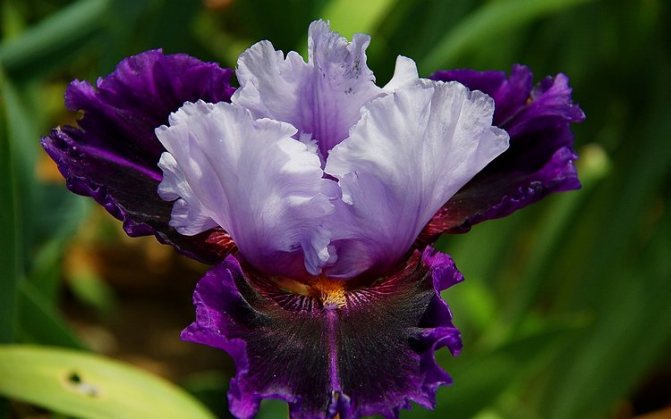

Planting process
If root crops are planted in spring, then this should be done during the emergence of sprouts before flowering, almost immediately after the snow melts. Closely spaced roots can be gently pryed off with a pitchfork, after loosening the soil along the edge of the roots. However, you won't have to expect flowers this year, because the plant gives off strength for survival.
We dig a hole for planting half a meter deep for tall bushes, and less than a meter (30 cm) for curb or dwarf bushes. If you set out to bury the roots deeper, the plant will either die or push them to the surface. When to plant flowers in summer, you will be prompted to color the buds. The hatched peduncles are removed and thrown away, and the neighboring children are planted in a hole. The root collar has a slight bend. It is the convex bend that we turn to the south and, after falling asleep with earth, we thoroughly water the seat. Before planting, it is preferable to hold the seedlings in the sun for 2-3 days in order to neutralize them from diseases and increase germination. In the fall, we do similar machinations, not forgetting to cut off not only the flowering shoots, but also the leaves with an angular cut from the edge to the middle. Thus, maintaining the vitality of the roots. So you learned how to plant irises correctly.
How to plant irises
In the first half of autumn, all bulbous varieties are planted. To do this, follow the sequence of actions:
- Create a hole 15–20 cm deep. The distance between the holes is equal to four diameters of the onion.
- The bulb is carefully placed in the hole, without screwing in and other physical influences.
- The plant is covered, lightly tamped the soil, watered with water.
- Mulching is performed. The layer thickness is 10–20 cm.
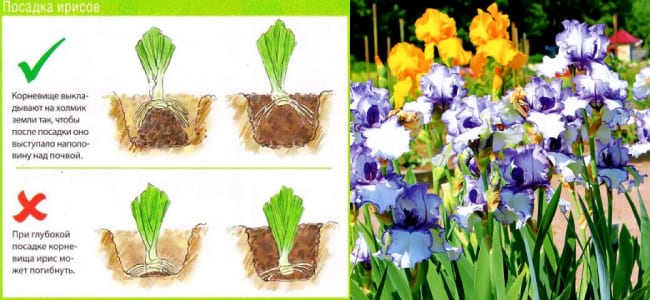

Planted irises
Disembarkation dates
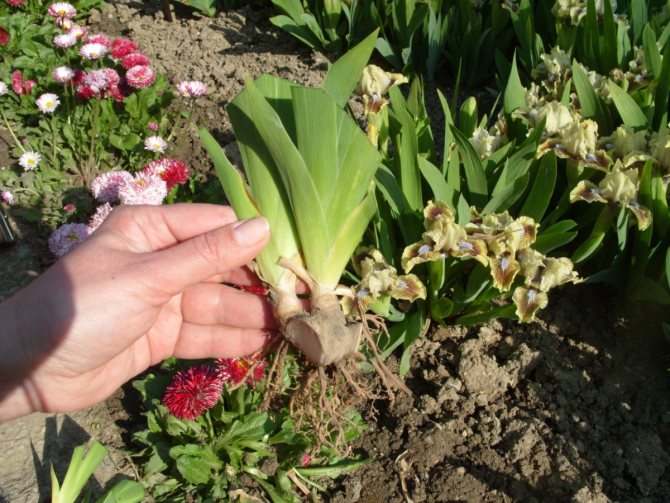

The specific dates of planting are chosen based on the climatic conditions of the region and weather conditions. After being placed in the ground, the iris needs 1.5 months for successful rooting. If you are late, the sudden onset of freezing temperatures can destroy the plant or lead to partial decay of the roots in winter.
Recommended landing dates by region:
| Region | Recommended timing |
| South | Mid to late October |
| Middle lane and Moscow region | Mid to late September |
| Leningrad region | First half of August |
| Siberia and the Urals | End of July - first decade of August |
Successful dates of the lunar calendar:
- 2-4, 11-12, 15-17 September;
- October 1, 4–6, 12–14, 19–21.
Preparing seedlings for wintering


After planting, water the plant only after three days
After planting, irises require care. It consists in carrying out several procedures:
- Watering. If there is no heavy rainfall, irises should be watered 3-4 days after planting.
- Weeding. The beds must be regularly weed-free. In the process, it is important not to touch young roots that are close to the ground.
- Mulching. As the cold weather approaches, it is important to monitor the temperature. Before the onset of the first frost, the roots must be mulched with spruce branches, dry foliage or peat. It is impossible to insulate earlier, otherwise the roots will overheat and may rot. Remove the layer of leaves immediately after the snow melts.
Pests and diseases
As you may have guessed, your plant does not require additional care, but sometimes due to high humidity or transmission of infection by other plants, it can become infected.
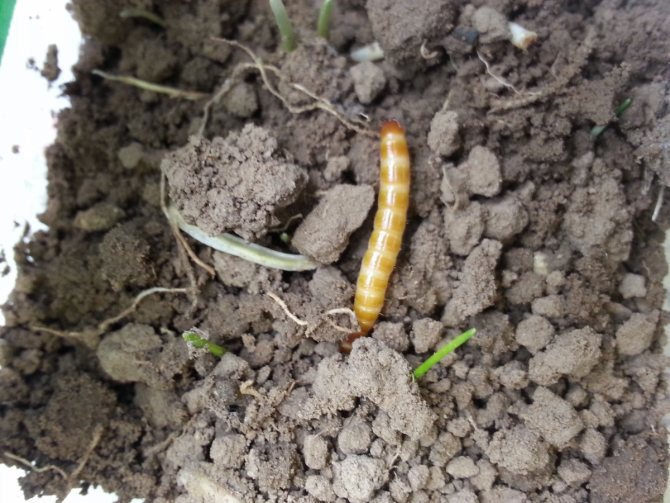

Photo:
The more unusual the variety, the more susceptible to disease it is. There are few of them, but future gardeners need to know about them:
- rot can affect the root or part of it. In case of partial defeat, carefully cut out the infected area, sprinkle with ashes and fry in the sun. In case of complete defeat by rot, we throw out the root in order to avoid transmission of decay to other plants. We treat the soil and other roots with a solution of foundationol in a 2% ratio;
- rust and leaf spot are removed by spraying with 1% Bordeaux mixture. The procedure is carried out in the spring before the appearance of the shoots, and in the fall after cutting the pedicels and leaves before wintering;
- scoop is able to settle at the base of the peduncle and prevent it from developing. A solution of karbofos in a 10% ratio will perfectly cope with the pest. Treatment is carried out at the beginning of vegetation twice with an interval of 12-15 days;
- thrips grow in leaves and buds, preventing them from fully blooming and blooming. The leaves turn brown and dry. Spraying with a solution of karbofos 10% will relieve the disease;
- slugs disappear on sandy loam soils. If they overcome, add sand to the soil (or pour it) and the slugs will become much less, since they do not like dry places. You can put a board or a wet rag, and then they will crawl under them, and you will take and throw away or scrape off the slugs with snails from the board;
- the bear is afraid of a solution of chicken droppings. It is poured on a dry day around the flower bed or along the paths. The smell of marigolds scares this beetle away, or they use pesticides intended directly from the bear;
- wireworm is not found in soil with a normal pH level, therefore, in acidic soils, neutralization is done in the form of an introduction of ash, chalk, dolomite, lime. Ammonium nitrate or ammonium sulfate will get rid of the wireworm if you add them at 20-30 grams. per m2. Loosening and weeding facilitates this procedure.
Bulbous
Plants are divided into groups: iridodictium, xyphium and juno. The second type includes six subspecies. Breeders cross them and develop new varieties of flowers. In this way, English, Dutch, Spanish hybrid irises were created. The most common types:
- Iridodictium reticulated;
- Irises Vinogradov;
- Dunford;
- Kolpakovsky;
- Variegated;
- Bukhara;
- Great;
- Greberianovsky;
- Dwarf bearded men.
The color line of the buds is varied and depends on the variety. Irises are burgundy, blue, blue, lilac, yellow and other tones. They will decorate the terrain in various regions of the country, they are able to take root in any environment.
Advantages and disadvantages of autumn planting


Irises are a rather unpretentious plant
This perennial plant grows rapidly. So that this does not affect its flowering, it is recommended to divide the bush every few years and replant young irises. You can do this at any time, but experienced flower growers recommend transplanting in the fall. After all, such a transplant has many advantages.
- For about a month and a half, rooting takes place, the plants adapt to the new soil. Therefore, if planted in spring, no flowers will appear that year. And with an autumn planting, the plant will be able to take root before frost.
- Immediately after transplanting, young plants are very vulnerable to pests. And in the spring there are many of them, so they can destroy the seedlings.
- By the end of August, the roots stop growing. The kidneys become stronger and become clearly visible. Therefore, it is easier to divide the bush.
- In the fall, gardeners have less hassle, so you can prepare the soil without haste and plant the plants correctly.
The disadvantage of planting in the fall may be the wrong timing. If you do this too late, the irises will not have time to take root and die before the frost.
Iris care
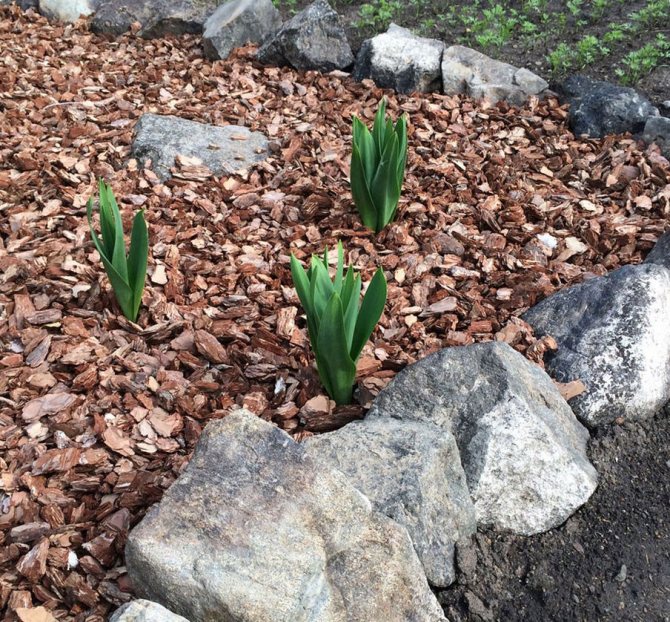

It is necessary to rid the irises of weeds - this will create conditions for better vegetation.
After planting, water the plants no earlier than 3-5 days if there is no rain. It is important to remove weeds on time, and, moreover, this must be done manually.Fertilizing is not necessary, especially with manure, as this can stimulate untimely growth.
Shortly before the onset of frost, it is advisable to mulch the rhizomes. In cold regions, this is a must. For mulching, you can use peat, straw, dry leaves, sawdust, pine needles. In the spring, the mulch must be removed.
Varieties and varieties
“Iris” is the general name for plants with a rhizome and bulbous axial vegetative organ. Both species are thickened shoots.
There is no general classification of these colors. In Russia, rhizomatous irises are considered real irises, and bulbous throughout the world.
All varieties fit the general description: the iris has an annual flower stem with a large bud that exudes a pleasant aroma. The plates are thin, flat, with a waxy coating. The flower has six petals arranged in two rows: three of them bend outward, the inner ones are raised to the top with a dome.
Scheme and depth of planting of bulbs or rhizomes of irises
Before planting, the prepared flower bed is once again slightly loosened, leveled, and holes for irises are made. The interval between them depends on the size of the adult plant. Dwarf irises are planted every 15–25 cm, others after 50–70 cm. Bearded irises are especially prone to spreading in breadth. The depth of the hole is determined by the dimensions and is approximately three heights of the bulb, rhizome (on average 12-15 cm).
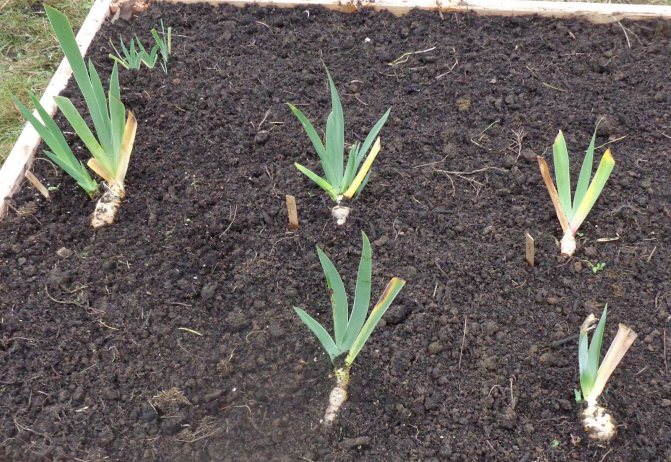

The interval between the holes for planting irises is determined by the dimensions of an adult plant
Video: what are the nuances of the autumn planting of irises you need to know
The disembarkation procedure itself is as follows:
- To disinfect, soak the planting material for about an hour in a pale pink solution of potassium permanganate. Also, fungicides are used for disinfection (Maxim, Alirin-B, Bayleton, Fitosporin). In this case, the processing time is reduced to 15–20 minutes.
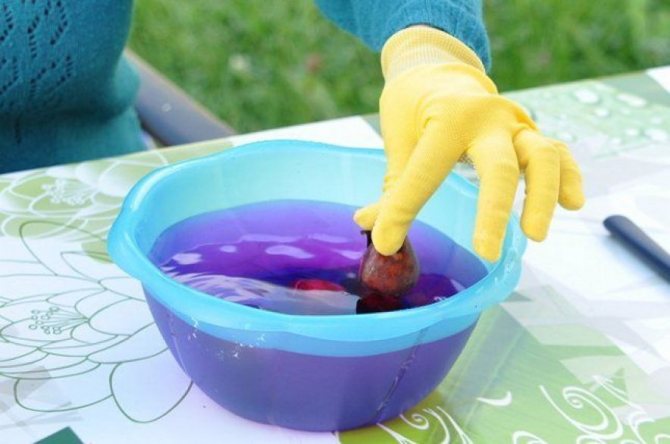

Potassium permanganate is one of the most affordable disinfectants that has long proven its effectiveness. - At the bottom of the planting hole, throw a handful of sand, form a small mound of soil. Put the rhizome or bulb on it with the growth buds up, spread the existing roots along its "slopes", preventing them from bending up and to the sides.
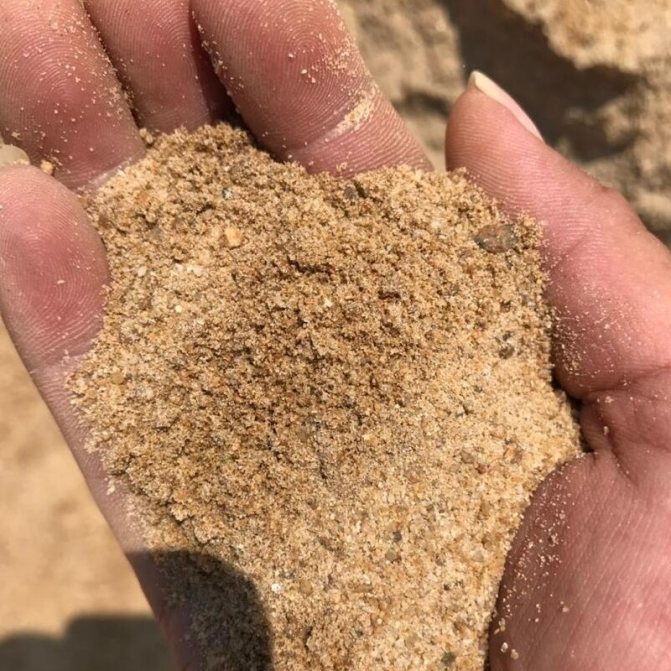

The sand at the bottom of the hole is a drainage that prevents moisture from stagnating at the roots of the iris - Cover the holes with soil while compacting the soil with your hands. The root collar (in a strictly vertical position) and the upper part of the rhizome with a bend should eventually be 2-3 cm above the ground. It is desirable to orient this bend to the south, contributing to the formation of shoots.
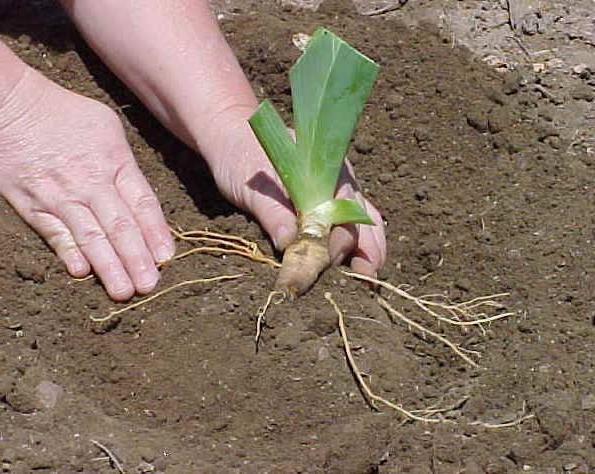

When planting irises, be sure to leave the top of the rhizome on the surface - Water the plants (0.8–1 l each). Beardless, Siberian and bog irises are recommended to be additionally mulched to retain moisture in the soil.
Video: features of planting bulbous irises
Preparation of planting material
Choose a plant with a firm, coherent rhizome, fresh and green leaf fan. There should be several links on a bush with roots, ideally if bumps will be visible on them. Hair roots are undesirable - they will break off during planting. The normal color of the root cut is uniform, without blackness and rot. It is better to buy iris during the flowering period, when it has an aboveground part.
A high-quality bulb has elasticity, a rounded shape without lateral growths, and has no signs of damage and rot. If the planting material does not meet the requirements, it must be prepared:
- Carefully cut a root that is too long.
- Cut off damaged and rotten areas.
- Within 20 minutes, disinfect the rhizome in a weak solution of potassium permanganate, dry the cut in the sun.
- After purchase, treat the planting material with a biostimulant.
- Cut the sections with a mixture of crushed coal and sulfur, the proportion is 1: 1.
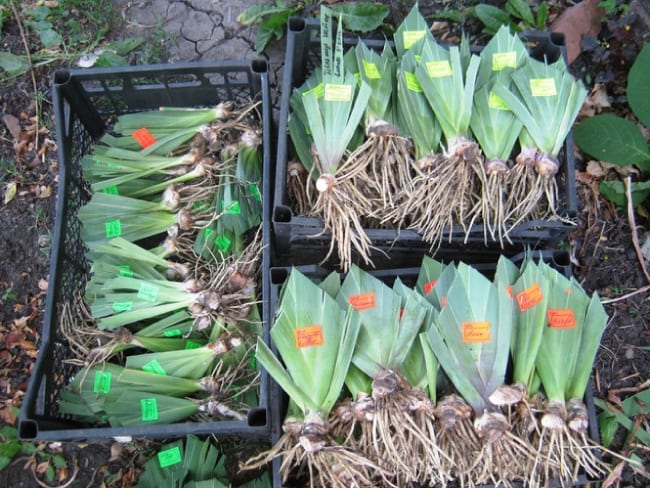

Irises before planting
The meaning of the iris flower
Different countries interpret the meaning of the iris flower in their own way.For example, in Japan, this flower symbolizes courage and warlike spirit, because even the very shape of the leaves resembles a sword. Christians associate the image of a flower with compassion: Flemish painters, depicting the image of the Virgin Mary, painted irises and lilies near her. The ancient Greek goddess Iris walked on the rainbow to bring people news from the gods. From the Greek language, the translation of the name of the flower will mean "rainbow", this has already been mentioned above.
Even now, irises are depicted on the coat of arms of the city of Florence, as a symbol of prosperity. And in Russia, this flower used to be (and still) was called iris, from the word "scythe", hinting at its narrow, sharp leaves. Today, these beautiful flowers symbolize respect, good intentions, and an assurance of friendship. They can be given to everyone without fear, they carry a good message, a positive meaning.
Irises look impressive together with other brightly colored flowers, decorate any flower bed, add charm to even the simplest area. Irises are diverse in their magnificence and undemanding, planting and care in the open field does not pose any particular concerns for the summer resident. This is just the case when, with minimal labor costs, you can enjoy excellent results throughout almost the entire summer.
Dwarf iris
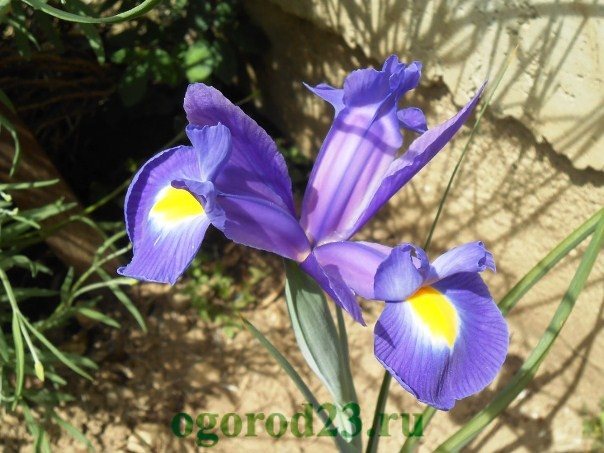

Iris Blue Magic
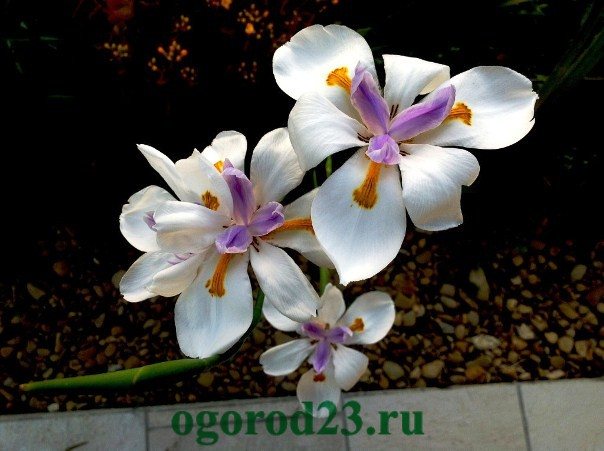

Iris African Dietes
Typical mistakes of a novice florist
The main mistake when planting irises is excessive deepening into the ground. As a result, rhizomes and bulbs rot, plants die. Also, serious negative consequences in the form of a lack of flowering entail the wrong choice of place. The worst thing for irises is a lack of light and (with the exception of some varieties) waterlogged soil.
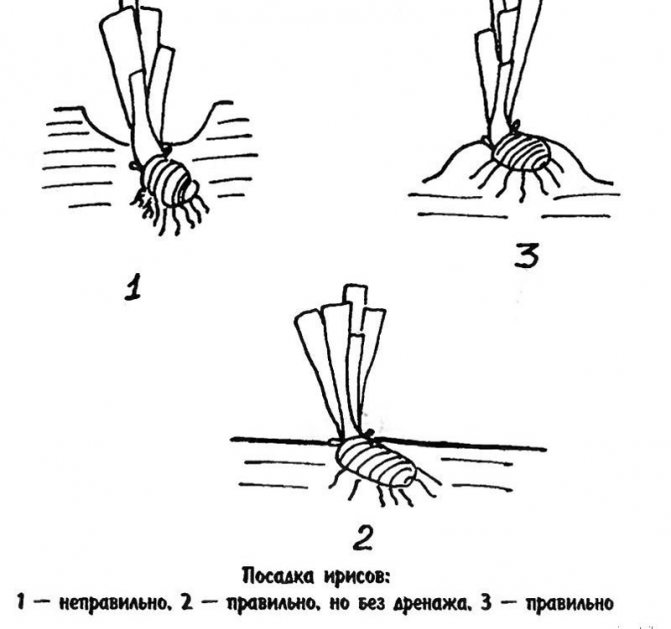

Excessive deepening of the bulb or rhizome of the iris is the most common mistake that provokes the death of the plant due to the development of rot
Diseases
Iris can be attacked by various diseases if not properly cared for. With poor content, fungal and viral infections appear:
| Disease | Description | Control methods |
| Mosaic | Provoked by aphids. Pathological stripes, spotting of various sizes and forms of a yellowish color appear on the greenery. The leaf plates become "crumpled", embossed. Pathology is spreading rapidly. | The disease is infectious; there are no effective methods of dealing with it. To avoid the occurrence, prevention is necessary: follow all watering rules, fertilize the plant. In the store, it is recommended to purchase preparations for insect pests and treat flowers with them: Actellik, Confidor. If the iris is nevertheless struck by the disease, then the infected leaves must be immediately destroyed. |
| Bacterial rot | Brown spots form on the green. The disease is detected in the spring after wintering. It is provoked by freezing of the rhizome, strong soil moisture, close planting, lack of calcium and phosphorus in the substrate. | The affected leaves must be torn off, the injured area must be treated with a solution of potassium permanganate. If the pathology has affected the plant too much, then it will have to be destroyed, the soil should be disinfected with purchased antibacterial agents (Maxim, Fitolavin). |
| Gray rot | Infects leaves or root system. Usually, the disease occurs due to stagnation of moisture in the ground. Therefore, iris needs good drainage (with the exception of the marsh variety). Also, the reason is the lack of nutrients in the soil. | Treatment is carried out with fungicides (Trichophyte, Fitodoctor, Fitosporin, Mikosan). When the pathological condition is neglected, the irises are destroyed. |
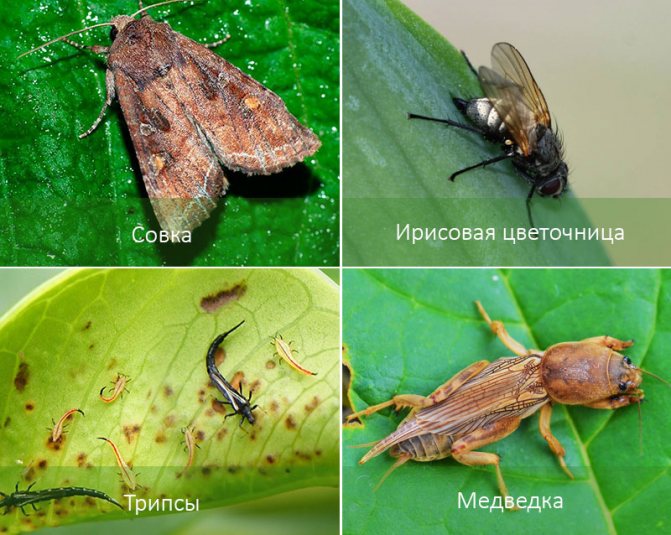

Digging the bulbs
Experienced gardeners strongly advise to dig up iris bulbs, especially when it comes to Dutch varieties, otherwise they may rot due to frequent rains. If the bulbs of other early flowers are dug after their leaves are completely dry, then there is no need to wait so long with the cockerels.
As soon as the leaves turn yellow, as a rule, this happens 12-14 days after they have faded, the bulbs can be removed from the ground.


Note!
If the summer in the region is dry, that is, it is unlikely that it will rain, then it is not necessary to dig out the bulbs during this season.
The dug out bulbs must be treated with a weak solution of manganese, then dried for 2-3 weeks and stored in a ventilated room.
Choosing the right time
The correct planting time for this crop depends on both the plant variety and the growing region.... Nevertheless, there is a rule that avoids gross miscalculations in the choice of landing time. It prescribes planting iris plants no later than 5-6 weeks before the arrival of stable cold weather.
In regions with harsh climates
In the Urals and Siberia, which are distinguished by cold climatic characteristics, the preferred time for planting irises is the entire last summer month and the very beginning of September... The same planting dates are recommended for the Leningrad region.
Did you know? Iris belongs to the oldest flowers that people have introduced into their everyday life. These crops were grown in Assyria and Mesopotamia.
With a temperate climate
A temperate climate is observed in the Middle zone. For example, in the suburbs. In these regions, these flowers are usually planted in early autumn. The most preferred period is from 1 to 15 September... In this case, there is still enough time before the onset of stable cold weather.
Warm climate
In the southern regions, colds come later. Therefore, the planting dates for the iris culture are shifted towards later autumn. Usually, the planting of irises is timed to the very end of September.... But sometimes it can last until the end of October.
Video: planting irises
Watering plants and applying fertilizers
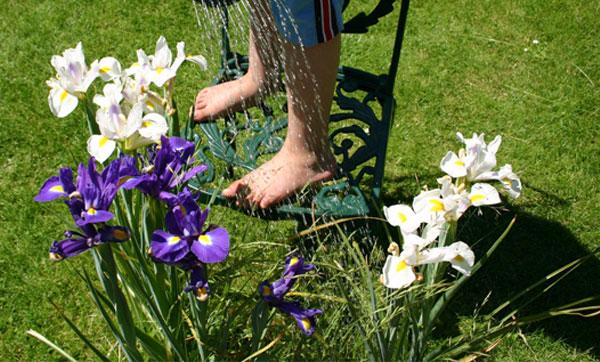

Only recently transplanted plants need regular watering. Iris does not tolerate excess and sudden changes in moisture levels. Gardeners plant this plant on slopes where water does not retain, and other flowers die from lack of water. The iris has enough natural rain throughout the year. An exception is the flowering period: then too dry soil is carefully watered, trying not to get water on flowers and bushes, in the evening. After flowering, watering is stopped - at the time of the growth of new roots, excess moisture leads to their decay. Young plants are especially sensitive to "overflow".
For feeding, only mineral fertilizers are used, since organic ones provoke rot. Usually, it is enough to add phosphorus-potassium mixtures in the spring at the rate of 10 g per 1 m2. They must be dissolved in water, the granules can burn the protruding parts of the roots. If the bushes are weakly gaining leaf mass, nitrogen fertilizers are additionally applied in the summer at the same concentration.
Rhizome
Subdivided into bearded and non-bearded. They are picky about leaving, calmly endure the frosts of the Moscow region and other regions of the country. Bearded are classified into subspecies: Siberian, Spuria, Japanese, Louisiana.
Low-growing varieties reach 25-35 centimeters (Gold of Canada). Medium-sized ones grow up to 50 centimeters (Blue Stakatto, Burgomaster, Kentaki Derby, Kilt Aylt). Tall - the largest plants, the length of the leaf plate is up to 70 centimeters (Arkady Raikin, Beverly Hills, Sultan).
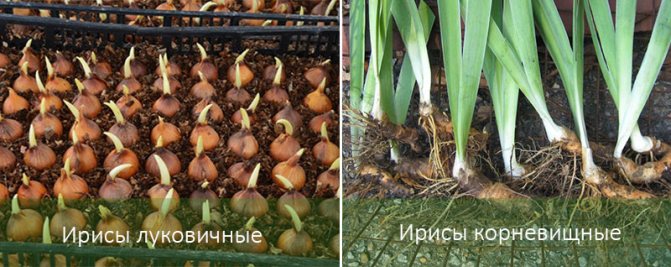

The right place and soil for a flower bed
The unpretentiousness of irises allows them to take root in almost any conditions. But abundant flowering and maximum decorativeness can be achieved if the "wishes" of the plant are taken into account:
- Good illumination (open area or light partial shade). Irisam is suitable for a small hill or a place on the side of a hill closer to the top.You cannot plant them under tall trees, bushes with a dense crown and next to them - the sun is needed not only for flowers and leaves, but also for the roots. In the shade, flower buds are not formed. In general, irises are picky about the choice of neighbors, they get along well with any flowers.


Irises are livable - you can plant any other flowers in the flowerbed next to them - No cold drafts. It is desirable to have an obstacle at some distance that protects the irises, but does not obscure them.
- Groundwater located 1.5 m above the soil surface or below. The root system of irises is superficial, stagnant moisture will provoke the development of rot. Bearded irises are especially negative towards this, but Siberian and marsh irises are an exception, they can tolerate waterlogged soil.
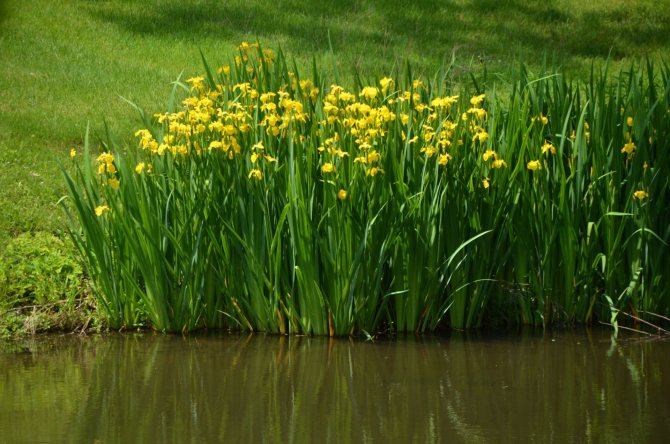

Swamp irises, as the name suggests, feel comfortable almost in the water, but this does not apply to other varieties. - Fertile soil, neutral or slightly acidic, good air and water permeability. Bearded irises successfully take root even in rocky substrates.
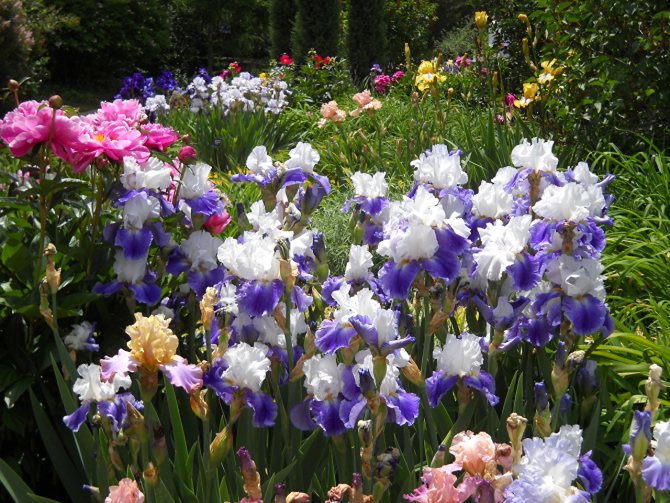

The most abundant and long-lasting flowering of irises is shown when planting in an open area, where they will have enough sun

